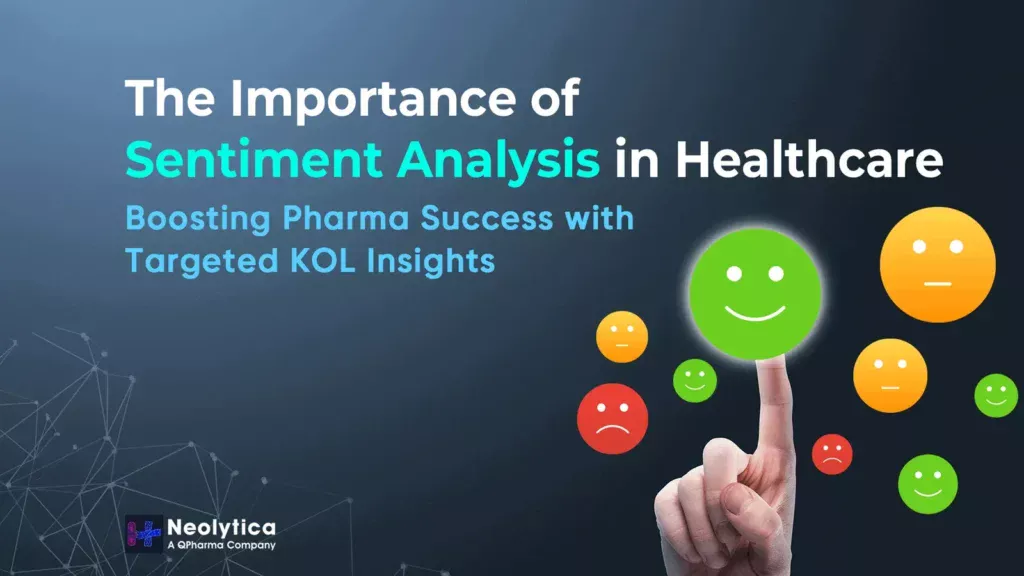Table of Contents
What is sentiment analysis?
Sentiment analysis analyzes your KOL’s sentiments towards products, companies, brands and focus areas to understand whether these opinions are positive, negative, or neutral. Sentiment analysis helps pharma companies to engage with KOLs. This is accomplished by analyzing every activity of the KOLs to understand their sentiments will help create customized preference-based conversations between the field teams and KOLs.
Understanding sentiment analysis
At its core, Sentiment Analysis is the process of evaluating data to determine if the expressed opinions are positive, negative, or neutral. For pharma companies, this involves analyzing the sentiments of KOLs towards their brand, product, topic, etc. By looking at the activities of KOLs, such as publications, clinical trial data, conferences, and social media interactions, pharma companies can gain insights into their preferences, opinions, and potential biases.
Add Your Heading Text Here
The strategic importance of KOL sentiment analysis
Crafting strategies
Understanding KOL sentiment helps pharma companies develop competitive network strategies. By identifying positive, negative, and neutral opinions about their products, pharma companies can develop better engagement options with the KOLs. This strategic engagement can influence the broader network of stakeholders and HCPs, ultimately affecting market dynamics.
Customized conversations
Analyzing every activity of KOLs allows for creating customized preference-based conversations. Field teams can engage with KOLs in discussions that resonate with their interests and opinions, creating stronger relationships. Personalized interactions based on sentiment analysis will increase the possibility of positive reception and support from the KOLs.
Influencing negative and neutral opinions
One of the significant advantages of sentiment analysis is the ability to identify and target KOLs with negative or neutral opinions. With the help of the KOLs with positive sentiments, companies can strategically engage with the KOLs with less favorable views. Positive KOLs can help alter the sentiments of KOLs with negative, neutral, or no sentiment towards a product.
The process of sentiment analysis
- Data collection: The first step to sentiment analysis is the collection of data from various sources, including publications, events, press releases, blogs, podcasts, forums, and social media like YouTube, Facebook, Twitter, LinkedIn, etc. We analyze over 10+ years of extensive KOL data to develop a comprehensive sentiment analysis.
- Manual analysis by medical experts: The data collected is then analyzed manually by our medical experts, who then develop the positive, negative, or neutral sentiment conclusions for each KOL. Manual analysis ensures higher accuracy in identifying the sentiments as medical experts can contextualize the sentiments of KOLs within specific scientific and medical domains.
- Sentiment Categorization: Each piece of data is categorized based on the sentiment expressed. Positive, negative, and neutral sentiments are tagged accordingly, providing a clear picture of KOL opinions toward specific products, brands, or treatment approaches.
- Trend monitoring and tracking: KOL sentiments are monitored continuously to identify trends and track changes. The ongoing monitoring and analysis help pharma companies stay updated with the shifts in opinions and emerging trends in the healthcare landscape.
Leveraging Sentiment Analysis for strategic advantages
Enhancing strategies
By looking at the KOL’s preferences towards treatment algorithms,topics or brands, pharma companies can develop strategies and tactics for individual KOLs by aligning their messages and engagement efforts more effectively. This way, the company’s messaging can resonate with the KOL’s focus, increasing the likelihood of a positive response. The feedback received from the sentiment analysis can be leveraged to adjust the strategy and implement new ones.
Improving field team engagement
Sentiment analysis helps field teams increase their effectiveness by enabling more targeted and efficient engagement with KOLs.Understanding the sentiments and preferences of the KOLs makes it easier for field teams to focus their efforts on the KOL’s key concerns or to reinforce positive sentiments, maximizing the impact of the interactions. Sentiment analysis can also help measure the impact of field teams. Based on how the sentiments of KOLs are changed after active engagement from the field teams can be a KPI in measuring impact.
Identifying key influencers
Through sentiment analysis, pharma companies can identify key influencers within the KOL network. These KOLs can be engaged more strategically to amplify positive sentiments and mitigate negative ones. By focusing on the most impactful KOLs, companies can change the perception and acceptance of their products. For example, influential KOLs with positive sentiments will have affiliation with KOLs with negative, neutral, or no sentiment towards a certain product through different networks. These KOLs can help alter the sentiments of KOLs with negative, neutral, or no sentiment on the client’s product.
Personalizing marketing and communication
Personalized marketing and communication efforts based on sentiment analysis can significantly enhance the effectiveness of outreach programs. Creating customized messages for KOLs to engage their focus areas can help create long-lasting relationships and support.
Conclusion
Sentiment analysis has become a powerful tool for pharma companies aiming to engage KOLs effectively. By analyzing the KOL sentiments for their brand, services, or products, companies can create targeting strategies, increase the efficiency and effectiveness of field teams, and create strong relationships with KOLs. Strategic communication with these KOLs can drive positive reception for company products and brands.

